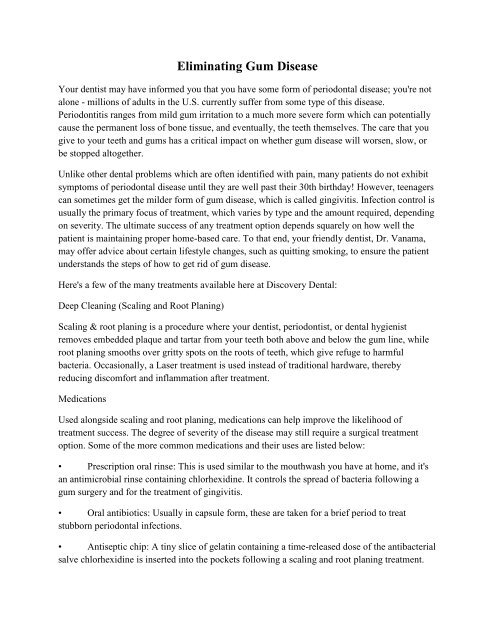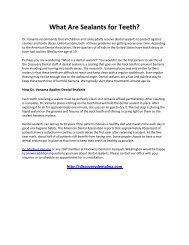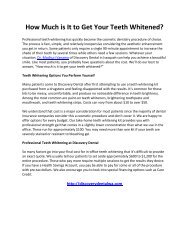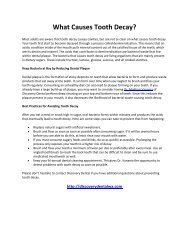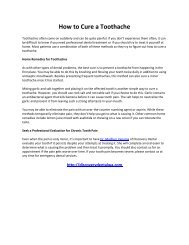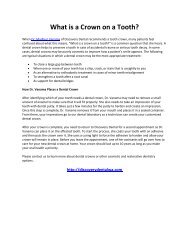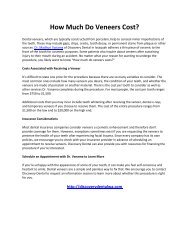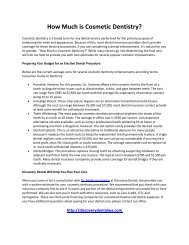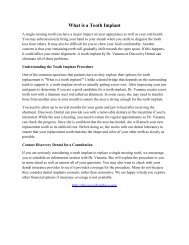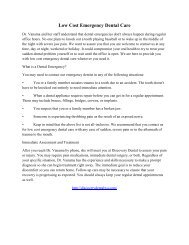Eliminating_Gum_Disease
Periodontal disease is a dental problem that affects the surrounding and supporting soft tissues of the teeth. At Discovery Dental WA, we offer advanced non-surgical and surgical treatments to treat gum disease.
Periodontal disease is a dental problem that affects the surrounding and supporting soft tissues of the teeth. At Discovery Dental WA, we offer advanced non-surgical and surgical treatments to treat gum disease.
Create successful ePaper yourself
Turn your PDF publications into a flip-book with our unique Google optimized e-Paper software.
<strong>Eliminating</strong> <strong>Gum</strong> <strong>Disease</strong><br />
Your dentist may have informed you that you have some form of periodontal disease; you're not<br />
alone - millions of adults in the U.S. currently suffer from some type of this disease.<br />
Periodontitis ranges from mild gum irritation to a much more severe form which can potentially<br />
cause the permanent loss of bone tissue, and eventually, the teeth themselves. The care that you<br />
give to your teeth and gums has a critical impact on whether gum disease will worsen, slow, or<br />
be stopped altogether.<br />
Unlike other dental problems which are often identified with pain, many patients do not exhibit<br />
symptoms of periodontal disease until they are well past their 30th birthday! However, teenagers<br />
can sometimes get the milder form of gum disease, which is called gingivitis. Infection control is<br />
usually the primary focus of treatment, which varies by type and the amount required, depending<br />
on severity. The ultimate success of any treatment option depends squarely on how well the<br />
patient is maintaining proper home-based care. To that end, your friendly dentist, Dr. Vanama,<br />
may offer advice about certain lifestyle changes, such as quitting smoking, to ensure the patient<br />
understands the steps of how to get rid of gum disease.<br />
Here's a few of the many treatments available here at Discovery Dental:<br />
Deep Cleaning (Scaling and Root Planing)<br />
Scaling & root planing is a procedure where your dentist, periodontist, or dental hygienist<br />
removes embedded plaque and tartar from your teeth both above and below the gum line, while<br />
root planing smooths over gritty spots on the roots of teeth, which give refuge to harmful<br />
bacteria. Occasionally, a Laser treatment is used instead of traditional hardware, thereby<br />
reducing discomfort and inflammation after treatment.<br />
Medications<br />
Used alongside scaling and root planing, medications can help improve the likelihood of<br />
treatment success. The degree of severity of the disease may still require a surgical treatment<br />
option. Some of the more common medications and their uses are listed below:<br />
• Prescription oral rinse: This is used similar to the mouthwash you have at home, and it's<br />
an antimicrobial rinse containing chlorhexidine. It controls the spread of bacteria following a<br />
gum surgery and for the treatment of gingivitis.<br />
• Oral antibiotics: Usually in capsule form, these are taken for a brief period to treat<br />
stubborn periodontal infections.<br />
• Antiseptic chip: A tiny slice of gelatin containing a time-released dose of the antibacterial<br />
salve chlorhexidine is inserted into the pockets following a scaling and root planing treatment.
This helps to slow or stop the spread of disease-causing bacteria, and help periodontal pockets to<br />
heal slightly over an extended period of time.<br />
• Microspheres (Arestin®): Scores of miniscule pellets containing minocycline<br />
hydrochloride, which feature a gradual time-release of antibiotics to control infection. They are<br />
inserted into the pockets which have formed between the teeth and gums following a scaling and<br />
root planing procedure.<br />
Dental Surgeries<br />
• Flap Surgery: Your dentist or periodontist may determine that the severity of infection<br />
made medications and deep cleaning ineffective. This type of surgery involves peeling back the<br />
gum tissue from the teeth to alter the periodontal pockets next to the teeth and/or eliminate deepseated<br />
tartar. Afterward, sutures are used to get the gums to fit securely around the teeth, and as<br />
the gums heal, they'll return to a tight fit around the tooth.<br />
• Bone and Tissue Graft: <strong>Gum</strong> and bone tissue which has been permanently lost will be<br />
restored through an advanced procedure, usually accompanying a flap surgery. Your dentist, may<br />
use synthetic or natural bone to fill in damaged areas, which may help promote regrowth. Guided<br />
tissue regeneration is a procedure where your dentist will sandwich a tiny slice of mesh between<br />
the gums and bone structure, preventing gum tissue from expanding into the places where bone<br />
is being replaced.<br />
http://discoverydentalwa.com/


